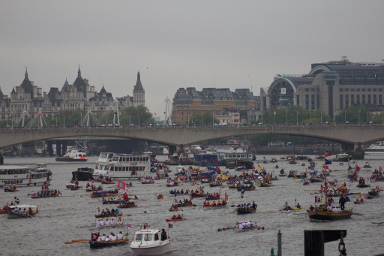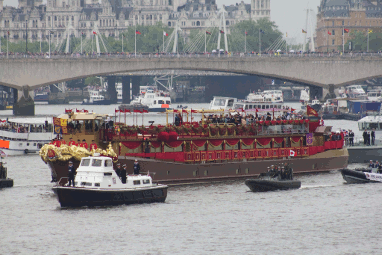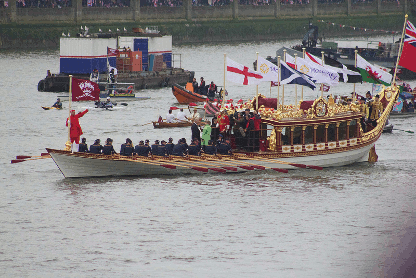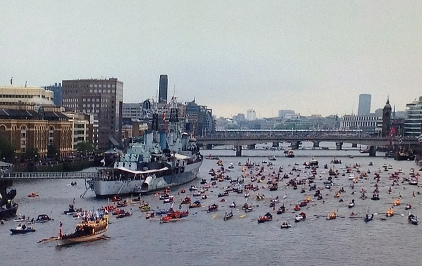The centrepiece of the Queen's Diamond Jubilee took place on the Thames in London on Sunday 3rd June 2012. Celebrating 60 years of the Queens reign, 1,000 boats, kayaks and watercraft took to the Thames in a spectacular seven mile long procession.
This is only the second time in history that a British monarch has lived to celebrate a diamond jubilee. The first and only other time was Queen Victoria's Diamond Jubilee in 1897. Now it was the turn of Queen Elizabeth II, and more than a million people lined the banks of the Thames to enjoy a jubilee event that none of them would be likely to experience again in their lives.
The 1,000 vessels on the Thames made it the biggest pageant on that river for over 350 years. The scale and majesty of the event was inspired by a painting from around 1746 by the Italian artist Canaletto of a Lord Mayor of London's pageant on the Thames. The painting had been kept in Prague, owned by the Lobkowicz Collections there, but has been brought to London's National Maritime Museum in Greenwich during the Jubilee celebrations. It shows the mediaeval guilds and livery companies of London who elected the Lord Mayor and who were displaying their status in the city. During the times of King Henry VII and Henry VIII and later Stuart Kings and Queens the Thames was often used as a grand processional route, including the firing of guns and music as part of the entertainment. Handel's Water Music, commissioned by King George I is one particularly memorable and stirring piece used historically, and which actually formed part of Queen Elizabeth's procession today. Adrian Evans, the Diamond Jubilee Pageant Master said today's event was planned to be even bigger and better than the exuberance and thrill featured in Canaletto's painting.
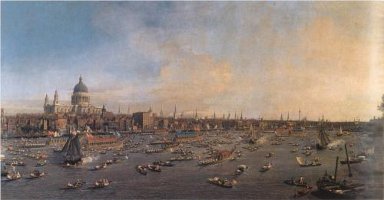
Canaletto's painting of boats on the Thames at an 18th century Lord Mayor's Day pageant.
Back in history, river pageants on the Thames had the benefit of the fact that the river then was twice as wide as it is today, and ran shallower and slower. The width of the river decreased, and the speed increased, when the embankments carrying the sewer systems came in. Today, the Thames barrier, further downriver from pageant itself, was closed to aid in keeping the waters as calm as possible by negating the ebb flow, and to help regulate the depth of the river.
All of the boats were chosen by the Thames Diamond Jubilee Pageant Team and the Port of London Authority. Some were selected because of their history, others simlpy to give a colourful mixture of different type of boats, from dinghies and kayaks through Dragon boats to vessels which work on the Thames and elsewhere. All of them had to undergo vigorous tests which were done over 3 and a half days before the pageant to confirm that they were in full working order to minimise the risk of any of them breaking down part-way through their procession downriver.
The event started at Chelsea Bridge, Prince Charles and at Camilla, Duchess of Corwall wearing a cream coat with diamond patterning on the sleeves, were greeted by Sir David Brewer, the Lord Lieutenant of Greater London. Making their way down to Chelea Pier, Charles and Camilla chatted with a guard of honour of Chelsea Pensioners standing to attention on a red carpet, all lined up in their traditional red uniforms. The Chelsea Pensioners are all residents at the Royal Chelsea Hospital, a retirement home founded by King Charlles II for ex-army members.
About an eighth of a nautical mile downriver at Cadogan Pier, Prince Harry, Prince William and Catherine, Duchess of Cambridge were met by the Deputy Lord Lieutenant of Greater London before having a quick chat with the crowds. Kate looked resplendent dressed in pure red, with a figure-hugging dress with pleated red high-knee-length skirt by Alexander McQueen, topped with a red floral hat by Sylvia Fletcher. Adding a watery theme to her outfit, Catherine wore a brooch featuring two dolphins. This was a gift from the Royal Navy Submarine Service, of which Prince William is Commodore in Chief. Being the Countess of Strathearn, Kate also appropriately carried in her hand a folded Strathearn tartan scarf, something which would come in very useful a little later in the day. The effect was completed by a small red clutch bag, citrine drop earrings and skin-colored shoes. Prince William looked smart in his Number One Dress Uniform as Flight Lieutent Wales of the Royal Air Force's Search and Rescue Squadron. His brother, Prince Harry, was equally dashing in his Blues and Royals Number One Ceremonial Dress as Captain of the Army Air Corps, the same uniform that he had worn to William and Catherine's wedding last year.
Boarding the Royal Barge, the Spirit of Chartwell, Prince William, Catherine and Prince Harry were greeted by a line of Royal Watermen standing to attention on the boat.
Back up at Chelsea Bridge, the Queen and Prince Philip, Duke of Edinburgh, arrived to an excited crowd, with the sounds of horns blaring a welcome in the background. Dressed in a white and silver coat and dress made by Angela Kelly, the Queen looked radiant for her Diamond Jubilee Pageant. Adorned with dozens of Swarovski crystals, and embroidered with gold, silver and ivory spots and a silk organza frill, the outfit took over a year to plan, and was designed to stand out against the colours of the Royal Barge. Her Majesty's royal head was crowned with a white upswept hat, decorated with hand-dyed feathers, more silk organza and Swarovski crystals. From the right angle the hat looked like it had a smiley face (at least to me, anyway) - probably not an intended effect but who knows? Prince Philip wore his Admiral of the Fleet ceremonial Day Dress.
After meeting with the row of 20 Chelsea Pensioners, the Queen and Prince Philip joined Prince Charles and Camilla. To a fanfare of 6 trumpets by Royal Marines onboard the Connaught, all four senior Royals made their way along the red-carpeted wakway to the Britannia Launch. With big beaming smiles from both Her Majesty and Prince Phillip, the Britannia Launch took off on its short journey to the Spirit of Chartwell. No doubt being onboard the Britannia Launch brought back happy memories of how this little boat had been used in the past to transport the Queen and her family to and from the Royal Yacht, Britannnia, which was decommissioned in 1997, at which time the Queen shed her only ever public tear.
As the Brittania Launch proceeded on its journey, the 6201 Princess Elizabeth steam train on Battersea Rail bridge blew its steam-powered horn in celebration. Built at Crewe in 1933 when the Queen was only 7 years old, and named after the young princess as she then was, the Princess Elizabeth cost £11,675 to build. Before its withdrawal from general service in 1962, the train broke a number of records including the record for the quickest steam powered locomotive journey from London to Glasgow and back, and also the record for the fastest and longest non-stop steam powered passenger train journey.
About 15 minutes, and around three quarters of a mile downstream from where they had begun their journey, the Queen, Prince Philip, Prince Charles and Camilla alighted from the Britannia Launch and on to the Royal barge, the Spirit of Chartwell. Bedecked with thousands of flowers, carefully sculpted plants, and gilded with gold leaf, the 220 feet long, 22 feet wide barge looked took three years to prepare for this special day.
With everyone in their rightful places, it was time for the river pageant to officially start, heralded by the leading barge, a craft weighing nearly 11 tonnes called the Belfry. Its 8 bells, one for each of the senior Royas, were created in the same foundry as the famous bell of Big Ben. As the Belfry' began to ring a quarter peal on its journey down the Thames, around 1,000 bells in churches beside the river and across the country rang out in reply. After the pageant these Royal Jubilee Bells will be installed at the 17th century Church of St James Garlickhythe in the City of London.
Following the Belfry, the Gloriana Royal Rowbarge led the manpowered section of about 260 boats, setting the pace at around 4 knots. Olympic gold medalists, Sir Steve Redgarve and Sir Matthew Pincent were among the 18 rowers on the 90 feet long Gloriana which was built especially for the Diamond Jubilee and is the largest rowed boat in the United Kingdom. As the multicolored rowboats of all shapes and sizes including canoes, dragon boats, gondolas passed the currently stationary Spirit of Chartwell, they "tossed oars", raising them at 90 degrees in salute to the Queen.
All of the flags of the British Commonwealth passed by next in fifty-six small Trinity 500 boats with outboard motors, crewed by UK sea cadets. Once they had gone by, slowly but steadily the Spirit of Chartwell powered itself into the center of the thames and forwards to join the pageant itself.
With the wind blowing across the ship, at one point whilst the Queen had popped below deck for a moment, Kate seemed to show William and Henry her hand which appeared to be shaking, probably due to the chilly breeze.
As the boats made their way downriver, a 41 gun salute echoed from cannons outside the Tower of London. Just past the London Eye, from the top of Royal festival Hall a group of 30 dancers used flags to send a message by semaphore to Her Majesty. The message read "Happy Diamond Jubilee Queen Elizabeth, We Heart You."
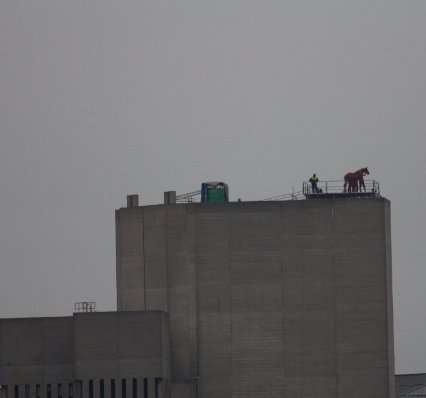
Joey the War Horse on top of the National Theatre.
Photo by Ian Patterson.
One of the highlights of the pageant happened as the Spirit of Chartwell passed the National Theatre where a spectacular War Horse display, which had taken 9 months to prepare, enthralled the Royal Party. Looking amazingly realistic on top of the Theatre, the War Horse, called Joey, neighed and raised one of its front hooves in a salute, followed by a bow to Her Majesty. The Queen, a great horse fan herself, seemed as impressed as everyone else, pointing and smiling at Joey on top of the building. Joey had previously visited the Queen at Windsor Castle.
A little further along at Westminster the Spirit of Chartwell passed a huge black and white photograph, on the side of Sea Containers House, of the Royal Family on the Buckingham Palace balcony at the Queen's Silver Jubilee in 1977. At 100 metres wide and 70 metres high, this was the largest photograph ever of the Royal family and took over a week to put in place.
Just before Tower Bridge, the Spirit of Chartwell passed the Royal Navy's 11,550 tonne cruiser, HMS Belfast. Veterans and Sea Cadets on the Belfast gave the queen a 3 cheer salute, before the bastules of Tower Bridge's central drawbridge were raised to their maximum elevation of 80 degrees in a Royal salute as the Royal barge passed through.
Once through Tower Bridge, The Spirit of Chartwell had completed its journey. The Royal barge moored up at HMS President which is the shore establisment of the London Division of the Royal Navy Reserve, and Royal party was able to enjoy the pass-by of boats which had been following them down the Thames. Opposite her, forming part of what was called "The Avenue of Sail" was the Tenacious, a tall ship which is specially rigged to allow disabled people to sail her.
By now the English weather had joined the celebrations, with rain pouring down heavily. Fortunately the Royals were able to shelter beneath a canopy on the Spirit of Chartwell. Although there had been two red thrones for the Queen and Prince Philip to sit on, neither of them had taken their seat, both remaining standing, which allowed the crowd and passing boats to have a good view of her. Despite the rain, the Royals seemed to be enjoying the procedings greatly, with the the Queen and Prince Philip smiling, laughing and waving as the boats went by. Catherine was putting her Strathearn tartan scarf to good use, with it wrapped around her neck to help protect her from the cold weather.
Immediately behind the Royal barge were 42 Dunkirk "Little Ships". These vessels had been part of Operation Dynamo during in the Second World War and had rushed across the English Channel to Dunkirk to transport thousands of Allied troops back to Britain after the troops had been cut off by the German Army. Today the Little Ships still make an annual crossing to Dunkirk as part of a society to remember those past heroic evacuations.
Following the Little Ships were 58 Historic and service vessels, blowing and honking their horns as they passed the Queen. These were followed by 50 working boats, comprising tugs and steamboats, then 67 recreational motorboats and fire vessels. At least one of the fireboats blew water high into the air to salute the queen.
Forty-three narrow boats and 20 barges from across the country were next to pass by. Before the days of motorways and railways, the UK's narrow boats and barges were the main methods of transport to carry goods around the country through a network of canals.
The last group to go by were 76 passenger boats, but this was not the absolute end. In an impressive grand finale, the London Philharmonic Orchestra music barge, called Symphony, brought up the rear of the pageant.
Unfortunately due to the bad weather, part of the grand finale had to be cancelled. There was going to be a flypast of a swordfish biplane and 9 helicopters going by in diamond formation to the sound of Jupiter by Holst played by the London Philharmonic Orcestra. Although this would have been very nice to see, its absence didn't make the pageant finale any less special.
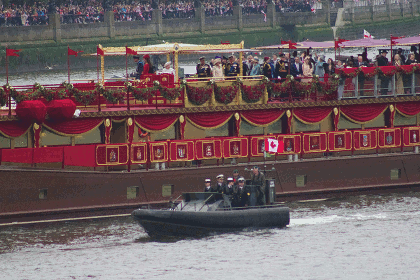
The Queen and Royal Family under the Spirit of Chartwell's canopy.
Photo by Ian Patterson.
Standing on top of the London Philharmonic Orchestra's barge, the Royal College of Music Chamber Choir bravely sang in the pouring rain, all of them completely drenched and soaking wet in what was now a deluge of water coming down from the skies. As they approached the Spirit of Chartwell, they sang "Land of Hope and Glory". The Symphony elegantly turned 180 degrees so that the singers could face the Queen as they stopped before the Royal barge. Whilst turning, the orchestra began to play The Sailor's Hornpipe, also fondly known to many as the tune to the children's program, Blue Peter. I don't know whether any of the Royal family watched Blue Peter when they were younger, or if they simply enjoyed the tune but they all definitely seemed to enjoy this with smiles on their faces. Prince Charles tapped his cane, Prince Philip nodded his head from side to side, and Camilla bobbed up and down in time to the music. The Queen smiled with glee at the end of the piece, with all the Royals clapping. This was followed by the singers bolting out a rousing "Rule Britannia" and "God Save The Queen" in fine voice despite continuing to be drenched by the rain.
A splendid firework display from the top ot Tower Bridge rounded off the proceedings before the bridge's bastules were lowered as ships honked and whistled and HMS Belfast fired its guns in salute.
As they left the Spirit of Chartwell to disembark at HMS President, the Royal ladies showed exactly how minutely detailled their fashion colour combinations were. In this pouring rain, even their umbrellas matched their outfits - the queen carrying a see-through umbralla with a white trim to match her white outfit, and Catheriine with a red brolly perfectly matching the red of her dress.
- Login to post comments
